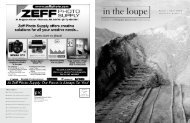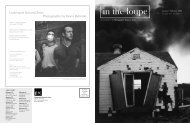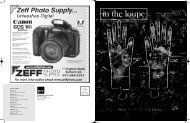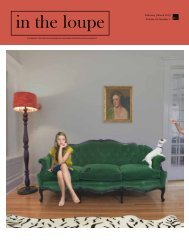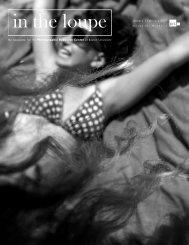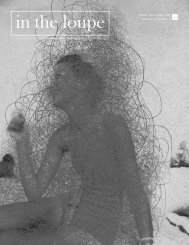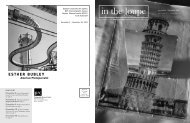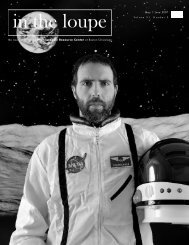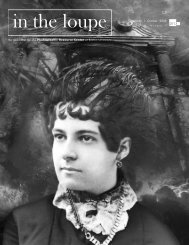March | April 2007 - Boston Photography Focus
March | April 2007 - Boston Photography Focus
March | April 2007 - Boston Photography Focus
- No tags were found...
Create successful ePaper yourself
Turn your PDF publications into a flip-book with our unique Google optimized e-Paper software.
A Little HistoryPardon me reader, if I part the curtain and take care of a little more business. I promise thatit will only serve to enlighten you, and won’t dampen our experience. We will be transporteda few hundreds years back in search of prototypes for these remarkable works ofart. Let us then reach into the history of optics and cinema to discover devices and machineswith such wondrous sounding names as the magic lantern, stereoscope, zoetrope, phenakistoscope,and mutoscope, and a whole host of other kinds of scopes and tropes.Most optical devices of this nature date from the early to mid 19th century and severalpre-date the invention of photography, although their roots can be traced to the Enlightenmentand before. Those related to animation, such as the Victorian parlor game of theThaumatrope, rely on a principle called “persistence of vision.” In this simple toy, twoimages are draw or printed on either side (most often a bird and a cage) and two stringsare attached to the edges. When twisted back and forth, the images are retained on ourretinas and appear to merge. These gadgets, together with celluloid film and projectors,laid the groundwork for the development of moving pictures and cinema in the 1890s. Thedevices’ etymology bears repeating as it too merges science and mystery: thaumatrope literallymeans “turning wonder”; zoetrope comes from the Greek words “life” and “turn”; andphenakistoscope, quite interestingly, stands for “deceptive viewer.” Other apparatuses exploitnatural tenancies of human physiology, such as stereo vision, or present visual conundrumsfor consideration or amusement.Known her for work on vanished optical devices and technological advances, cultural andart historian Barbara Maria Stafford has compared optical machines of earlier centuries tothose of the 21st in such publications as Devices of Wonder: From the World in a Box toImages on a Screen. The present exhibition intends to take this a step further by focusingsolely on contemporary artists who conjure up the spirit of previous eras in practice andphilosophy. Indeed, it underscores a seemingly endless human urge as raised by Stafford:“Why do people – in different parts of the world and in various epochs – insert a focusinglens or a convergent mirror, a flickering monitor or a tiny-screen ‘wearable’ between themselvesand their environment?” With that sentiment, let us leap back down the rabbit holeand discover a little more about Picture Show’s multi-talented polymaths. Follow me then, aswe meet our players roughly in the order in which we will encounter their work in the gallery.Steve HollingerSouth <strong>Boston</strong>, MASteve Hollinger sees sculpture as a conduit between the physical world and the world ofour emotions, our joy, desire, and despair. A visit to his studio reveals shelves filled to thebrim with objects and trinkets, including mica, polarizing filters, leaves, and optics. Hissolar-powered artworks sit perched near a large window, the daylight serving as inspirationand source. Hollinger’s use of antique boxes and objects shares kinship with the entrancingoeuvre of Joseph Cornell. In Supercollider, we see a man and a woman through twosmall oculars. When set in motion with a light, the fluttering stylized figures, loosely basedon Muybridge’s studies, run towards each other but never meet. In the background of Centotaph(a monument for the dead whose remains lie elsewhere) footage of nuclear testsprovides a background for a silhouetted armed figure as he performs an eerie, stylized“danse macabre.” Viewed through a prism, the flipbook and other hidden, inner workingsof Centotaph sit encased in an almost indestructible block of concrete. Hollinger is workingon a new mechanical piece to debut at this exhibition.Steve Hollinger, Cenotaph, 2003, responds tosunlight, materials include concrete, glass prism, animatedcards, latex binding, solar mechanism, 24 x10 x 14 inches, Courtesy of and collection of artistSteve Hollinger, Supercollider, 2004, responds tosunlight, materials include moving picture discs,strobe, solar mechanism, wooden box, 9 x 11 x 4inches, Courtesy of Chase Gallery, <strong>Boston</strong>




